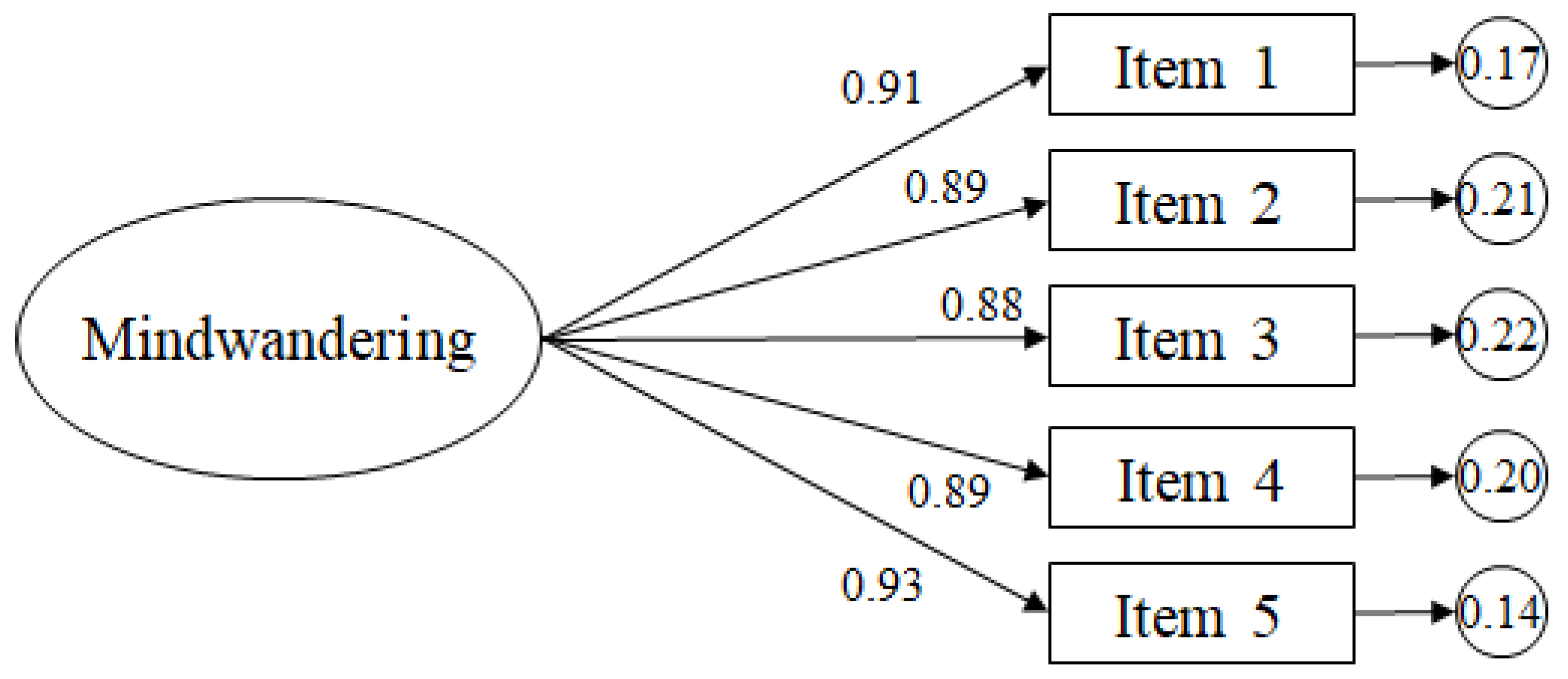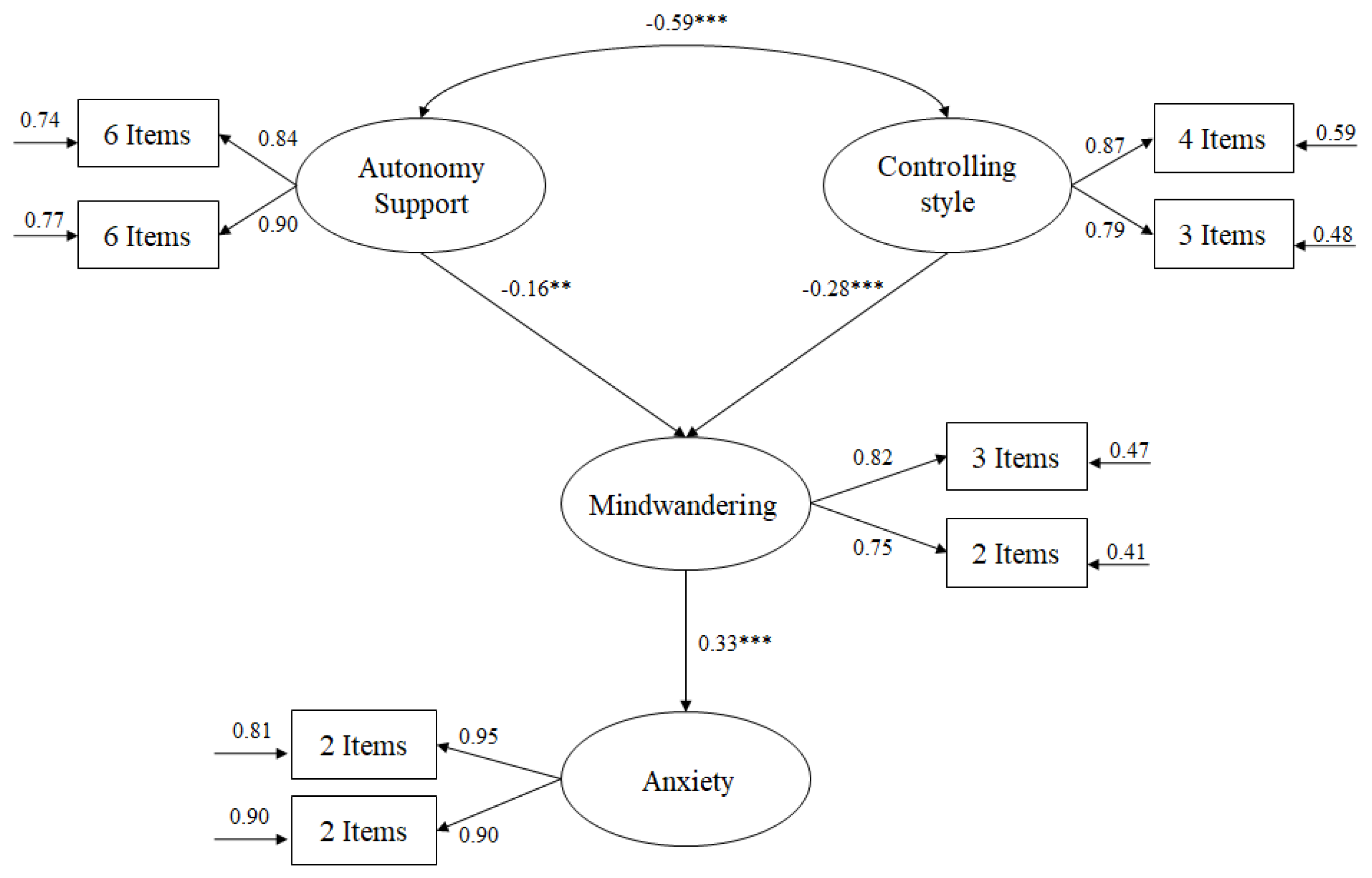Adaptation and Validation of the Mind-Wandering Questionnaire (MWQ) in Physical Education Classes and Analysis of Its Role as Mediator between Teacher and Anxiety
Abstract
1. Introduction
Experimental Overview
2. Method: Study 1
2.1. Participants
2.2. Instruments
2.3. Procedure
2.4. Data Analysis
2.5. Results
2.5.1. Confirmatory Factorial Analysis
2.5.2. Analysis of gender invariance
2.5.3. Descriptive Statistics and Reliability Analysis
3. Method: Study 2
3.1. Participants
3.2. Instruments
3.3. Procedure
3.4. Data Analyses
3.5. Descriptive Statistics and Reliability Analysis
3.6. Model of Structural Equations
4. Discussion
4.1. Discussion of Study 1
4.2. Discussion of Study 2
4.3. General Discussion
5. Conclusions
Author Contributions
Conflicts of Interest
Appendix A
| Mind-wandering |
|---|
| 1. Tengo dificultad para mantener la atención ante los ejercicios sencillos o repetitivos (Spanish). - I have difficulty keeping my attention to simple or repetitive exercises. |
| 2. Mientras hago los ejercicios tengo que repetirlos porque no he prestado atención (Spanish). - While doing the exercises I have to repeat them because I haven’t paid attention. |
| 3. Hago cosas sin prestar mucha atención (Spanish). - I do things without paying much attention. |
| 4. Me encuentro prestando atención y pensando en otra cosa al mismo tiempo (Spanish). - I find myself paying attention and thinking about something else at the same time. |
| 5. Me mente comienza a divagar durante las explicaciones del profesor o de los compañeros (Spanish). - My mind begins to wander during the explanations of the teacher or of the companions. |
References
- Chow, B.C.; McKenzie, T.L.; Louie, L.H.T. Children’s Physical Activity and Associated Variables during Preschool Physical Education. Adv. Phys. Educ. 2015, 5, 39–49. [Google Scholar] [CrossRef][Green Version]
- Lonsdale, C.; Rosenkranz, R.R.; Peralta, L.R.; Bennie, A.; Fahey, P.; Lubans, D.R. A systematic review and meta-analysis of interventions designed to increase moderate-to-vigorous physical activity in school physical education lessons. Prev. Med. 2013, 56, 152–161. [Google Scholar] [CrossRef] [PubMed]
- Rasberry, C.N.; Lee, S.M.; Robin, L.; Laris, B.; Russell, L.A.; Coyle, K.K.; Nihiser, A.J. The association between school-based physical activity, including physical education, and academic performance: A systematic review of the literature. Prev. Med. 2011, 52, S10–S20. [Google Scholar] [CrossRef] [PubMed]
- Ergas, O. Educating the wandering mind: Pedagogical mechanisms of mindfulness for a curricular blind spot. J. Transform. Educ. 2016, 14, 98–119. [Google Scholar] [CrossRef]
- Szpunar, K.K.; Moulton, S.T.; Schacter, D.L. Mind wandering and education: From the classroom to online learning. Front. Psychol. 2013, 4, 495. [Google Scholar] [CrossRef] [PubMed]
- Schooler, J.W.; Smallwood, J.; Christoff, K.; Handy, T.C.; Reichle, E.D.; Sayette, M.A. Meta-awareness, perceptual decoupling and the wandering mind. Trends Cogn. Sci. 2011, 15, 319–326. [Google Scholar] [CrossRef] [PubMed]
- Rey, L.; Extremera, N. Inteligencia emocional percibida, felicidad y estrategias distractoras en adolescentes. Bol. Psicol. 2012, 104, 87–101. [Google Scholar]
- Trigueros, R.; Aguilar-Parra, J.M.; Cangas, A.J.; López-Liria, R.; Álvarez, J.F. Influence of Physical Education Teachers on Motivation, Embarrassment and the Intention of Being Physically Active During Adolescence. Int. J. Environ. Res. Public Health 2019, 16, 2295. [Google Scholar] [CrossRef]
- Kasser, T.; Rosenblum, K.L.; Sameroff, A.J.; Deci, E.L.; Niemiec, C.P.; Ryan, R.M.; Hawks, S. Changes in materialism, changes in psychological well-being: Evidence from three longitudinal studies and an intervention experiment. Motiv. Emot. 2014, 38, 1–22. [Google Scholar] [CrossRef]
- Hasenkamp, W.; Wilson-Mendenhall, C.D.; Duncan, E.; Barsalou, L.W. Mind wandering and attention during focused meditation: A fine-grained temporal analysis of fluctuating cognitive states. NeuroImage 2012, 59, 750–760. [Google Scholar] [CrossRef]
- Poerio, G.L.; Totterdell, P.; Miles, E. Mind-wandering and negative mood: Does one thing really lead to another? Conscious Cogn. 2013, 22, 1412–1421. [Google Scholar] [CrossRef] [PubMed]
- Risko, E.F.; Anderson, N.; Sarwal, A.; Engelhardt, M.; Kingstone, A. Everyday attention: Variation in mind wandering and memory in a lecture. Appl. Cogn. Psychol. 2012, 26, 234–242. [Google Scholar] [CrossRef]
- Smallwood, J.; Fishman, D.J.; Schooler, J.W. Counting the cost of an absent mind: Mind wandering as an underrecognized influence on educational performance. Psychon. Bull. Rev. 2007, 14, 230–236. [Google Scholar] [CrossRef] [PubMed]
- Zeidan, F.; Johnson, S.K.; Diamond, B.J.; David, Z.; Goolkasian, P. Mindfulness meditation improves cognition: Evidence of brief mental training. Conscious. Cogn. 2010, 19, 597–605. [Google Scholar] [CrossRef] [PubMed]
- Zanesco, A.P.; King, B.G.; MacLean, K.A.; Jacobs, T.L.; Aichele, S.R.; Wallace, B.A.; Smallwood, J.; Schooler, J.W.; Saron, C.D. Meditation training influences mind wandering and mindless reading. Psychol. Conscious. Theory Res. Pract. 2016, 3, 12–33. [Google Scholar] [CrossRef]
- Kubesch, S.; Walk, L.; Spitzer, M.; Kammer, T.; Lainburg, A.; Hille, K. A 30-Minute Physical Education Program Improves Students’ Executive Attention. Mind Brain Educ. 2009, 3, 235–242. [Google Scholar] [CrossRef]
- Trigueros, R.; Gómez, N.N.; Aguilar-Parra, J.M.; León-Estrada, I. Influencia del docente de Educación Física sobre la confianza, diversión, la motivación y la intención de ser físicamente activo en la adolescencia. Cuad. Psicol. Deporte 2019, 19, 222–232. [Google Scholar]
- Ricard, N.C.; Pelletier, L.G. Dropping out of high school: The role of parent and teacher self-determination support, reciprocal friendships and academic motivation. Contemp. Educ. Psychol. 2016, 44, 32–40. [Google Scholar] [CrossRef]
- Vansteenkiste, M.; Ryan, R.M. On psychological growth and vulnerability: Basic psychological need satisfaction and need frustration as a unifying principle. J. Psychother. Integr. 2013, 23, 263–280. [Google Scholar] [CrossRef]
- Standage, M.; Gillison, F.B.; Ntoumanis, N.; Treasure, D.C. Predicting students’ physical activity and health-related well-being: A prospective cross-domain investigation of motivation across school physical education and exercise settings. J. Sport Exerc. Psychol. 2012, 34, 37–60. [Google Scholar] [CrossRef]
- Trigueros, R.; Navarro, N. La influencia del docente sobre la motivación, las estrategias de aprendizaje, pensamiento crítico de los estudiantes y rendimiento académico en el área de Educación Física. Psychol. Soc. Educ. 2019, 11, 137–150. [Google Scholar] [CrossRef]
- Mrazek, M.D.; Phillips, D.T.; Franklin, M.S.; Broadway, J.M.; Schooler, J.W. Young and restless: Validation of the Mind-Wandering Questionnaire (MWQ) reveals disruptive impact of mind-wandering for youth. Front. Psychol. 2013, 4, 560–573. [Google Scholar] [CrossRef]
- Hambleton, R.K. Adaptación de tests para su uso en diferentes idiomas y culturas: Fuentes de error, posibles soluciones y directrices prácticas. In Psicometría; Muñiz, J., Ed.; Universitas: Madrid, Spain, 1996; pp. 207–238. [Google Scholar]
- Lynn, M.R. Determination and Quantification of Content Validity. Nurs. Res. 1986, 35, 382. [Google Scholar] [CrossRef]
- Byrne, B.M. Structural Equation Modeling with Amos: Basic Concepts, Applications and Programming; Erlbaum: Mahwah, NJ, USA, 2001. [Google Scholar]
- Jöreskog, K.G.; Sörbom, D. LISREL 8: Structural Equation Modeling with the SIMPLIS Command Language; Scientific Software: Chicago, IL, USA, 1993. [Google Scholar]
- Bentler, P.M. EQS Structural Equations Program Manual; BMDP Statistical Software: Los Angeles, CA, USA, 1989. [Google Scholar]
- Schumacker, R.; Lomax, R.G. A Beginner’s Guide to Structural Equation Modelling; Lawrence Erlbaum Associates Inc.: Mahwah, NJ, USA, 1996. [Google Scholar]
- Browne, M.W.; Cudeck, R. Alternative ways of assessing model fit. In Testing Structural Equation Models; Bollen, K., Long, J., Eds.; Sage: Newbury Park, CA, USA, 1993; pp. 136–162. [Google Scholar]
- Hu, L.; Bentler, P.M. Cutoff criteria for fit indexes in covariance structure analysis: Conventional criteria versus new alternatives. Struct. Equ. Model. A Multidiscip. J. 1999, 6, 1–55. [Google Scholar] [CrossRef]
- Marsh, H.W. The Multidimensional Structure of Academic Self-Concept: Invariance over Gender and Age. Am. Educ. Res. J. 1993, 30, 841–860. [Google Scholar] [CrossRef]
- Moreno, J.A.; Parra, N.; González-Cutre, D. Influencia del apoyo a la autonomía, las metas sociales y la relación con los demás sobre la desmotivación en educación física. Psicothema 2008, 20, 636–641. [Google Scholar]
- Soenens, B.; Sierens, E.; Vansteenkiste, M.; Dochy, F.; Goossens, L. Psychologically controlling teaching: Examining outcomes, antecedents, and mediators. J. Educ. Psychol. 2012, 104, 108–120. [Google Scholar] [CrossRef]
- Trigueros, R.; Aguilar-Parra, J.M.; González-Santos, J.; Cangas, A.J. Validación y adaptación de la escala de control psicológico del profesor hacia las clases de educación física y su efecto sobre las frustraciones de las necesidades psicológicas básicas. Retos 2018, 37, 167–173. [Google Scholar]
- Trigueros, R.; Aguilar-Parra, J.M.; Cangas, A.J.; Álvarez, J. Validation of the Scale of Emotions. Sustainability. 2019, 11, 5006. [Google Scholar] [CrossRef]
- Marsh, H.W.; Richards, G.E.; Johnson, S.; Roche, L.; Tremayne, P. Physical Self-Description Questionnaire: Psychometric Properties and a Miiltitrait-Meltimethod Analysis of Relations to Existing Instruments. J. Sport Exerc. Psychol. 1994, 16, 270–305. [Google Scholar] [CrossRef]
- Cicchetti, D.V. Guidelines, criteria, and rules of thumb for evaluating normed and standardized assessment instruments in psychology. Psychol. Assess. 1994, 6, 284–290. [Google Scholar] [CrossRef]
- McVay, J.C.; Kane, M.J. Conducting the Train of Thought: Working Memory Capacity, Goal Neglect, and Mind Wandering in an Executive-Control Task. J. Exp. Psychol. Learn. Mem. Cogn. 2009, 35, 196–204. [Google Scholar] [CrossRef]
- McVay, J.C.; Kane, M.J. Does mind wandering reflect executive function or executive failure? Comment on Smallwood and Schooler (2006) and Watkins (2008). Psychol. Bull. 2010, 136, 188–207. [Google Scholar] [CrossRef]
- Smallwood, J.; Andrews-Hanna, J. Not all minds that wander are lost: The importance of a balanced perspective on the mind-wandering state. Front. Psychol. 2013, 4, 441. [Google Scholar] [CrossRef]
- Smallwood, J.; O’Connor, R.C.; Sudbery, M.V.; Obonsawin, M. Mindwandering and dysphoria. Cogn Emot. 2007, 21, 816–842. [Google Scholar] [CrossRef]
- Smallwood, J.; Fitzgerald, A.; Miles, L.K.; Phillips, L.H. Shifting moods, wandering minds: Negative moods lead the mind to wander. Emotion 2009, 9, 271–276. [Google Scholar] [CrossRef]


| Models | χ2 | df | χ2/df | Δχ2 | Δdf | CFI | IFI | RMSEA (CI 90%) | SRMR |
|---|---|---|---|---|---|---|---|---|---|
| Model 1 | 22.10 | 10 | 2.21 | - | - | 0.99 | 0.99 | 0.052 (0.022–0.082) | 0.034 |
| Model 2 | 26.52 | 14 | 1.90 | 4.42 | 4 | 0.99 | 0.99 | 0.045 (0.017–0.071) | 0.035 |
| Model 3 | 32.67 | 15 | 2.18 | 10.57 | 5 | 0.98 | 0.98 | 0.052 (0.027–0.076) | 0.059 |
| Model 4 | 38.27 | 20 | 1.91 | 16.17 ** | 10 | 0.98 | 0.98 | 0.045 (0.023–0.067) | 0.053 |
| Variables | M | SD | Range | α | AVE | 1 | 2 | 3 | 4 |
|---|---|---|---|---|---|---|---|---|---|
| 1. Controlling Psychology | 1.72 | 1.01 | 1–5 | 0.83 | 0.68 | −0.52 ** | 0.38 ** | 0.47 ** | |
| 2. Perceived Autonomy Support | 4.51 | 1.21 | 1–7 | 0.82 | 0.75 | −0.40 ** | −0.53 ** | ||
| 3. Mind-wandering | 2.15 | 1.19 | 1–6 | 0.94 | 0.61 | 0.51 ** | |||
| 4. Anxiety | 2.25 | 1.39 | 1–7 | 0.81 | 0.85 |
© 2019 by the authors. Licensee MDPI, Basel, Switzerland. This article is an open access article distributed under the terms and conditions of the Creative Commons Attribution (CC BY) license (http://creativecommons.org/licenses/by/4.0/).
Share and Cite
Trigueros, R.; Aguilar-Parra, J.M.; Álvarez, J.F.; Cangas, A.J. Adaptation and Validation of the Mind-Wandering Questionnaire (MWQ) in Physical Education Classes and Analysis of Its Role as Mediator between Teacher and Anxiety. Sustainability 2019, 11, 5081. https://doi.org/10.3390/su11185081
Trigueros R, Aguilar-Parra JM, Álvarez JF, Cangas AJ. Adaptation and Validation of the Mind-Wandering Questionnaire (MWQ) in Physical Education Classes and Analysis of Its Role as Mediator between Teacher and Anxiety. Sustainability. 2019; 11(18):5081. https://doi.org/10.3390/su11185081
Chicago/Turabian StyleTrigueros, Rubén, José M. Aguilar-Parra, Joaquín F. Álvarez, and Adolfo J. Cangas. 2019. "Adaptation and Validation of the Mind-Wandering Questionnaire (MWQ) in Physical Education Classes and Analysis of Its Role as Mediator between Teacher and Anxiety" Sustainability 11, no. 18: 5081. https://doi.org/10.3390/su11185081
APA StyleTrigueros, R., Aguilar-Parra, J. M., Álvarez, J. F., & Cangas, A. J. (2019). Adaptation and Validation of the Mind-Wandering Questionnaire (MWQ) in Physical Education Classes and Analysis of Its Role as Mediator between Teacher and Anxiety. Sustainability, 11(18), 5081. https://doi.org/10.3390/su11185081







